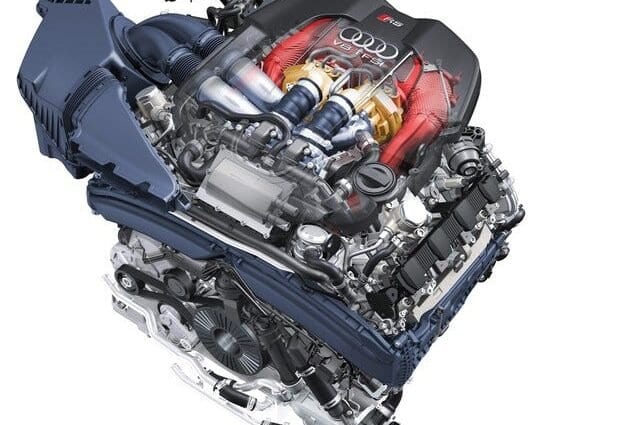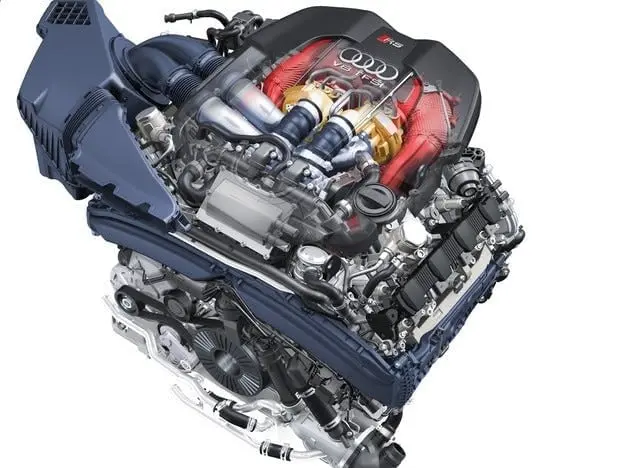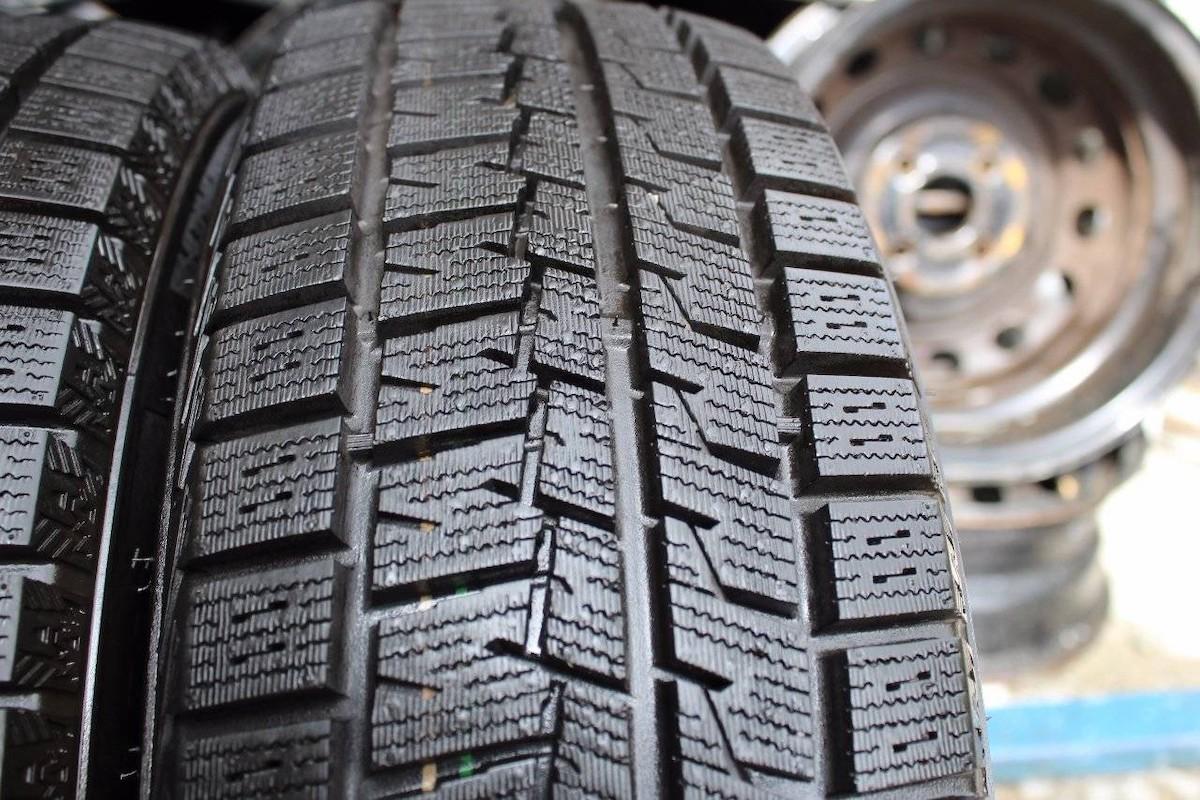
Audi engine test range - Part 2: 4.0 TFSI


Continuation of the series for the drive units of the brand
Audi and Bentley's eight-cylinder 4.0 TFSI is the epitome of downsizing in the upper classes. It replaced the naturally aspirated 4,2-litre engine and 5,2-litre V10 unit of the S6, S7 and S8 and was available in power levels from 420 to 520bhp. up to 605 hp depending on the model. At these figures, the Audi engine is a direct competitor to BMW's 4,4-liter N63 biturbo engine and its S63 version for the M-models. As with the BMW, the two turbochargers are placed on the inside of the cylinder banks, which are located at 90 degrees as with the previous 4,2-liter unit. With this arrangement, more compactness is achieved and the path of the exhaust gases is shortened. The twin-scroll configuration (at BMW it is only used in the S-version) allows reducing the mutual negative influence of the pulsations from the different cylinders and extracting a greater part of their kinetic energy, and is realized by a complex combination of channels from cylinders of different rows. This principle of operation provides a solid reserve of torque when accelerating even in modes slightly above idle speed. Even at 1000 rpm, the 4.0 TFSI already has 400 Nm. The more powerful version is ready to deliver its maximum torque of 650 Nm (700 on the 560 and 605 hp versions) throughout the range from 1750 to 5000 rpm, while the standard's 550 Nm is available even earlier - from 1400 to 5250 rpm. The engine block is made of aluminum alloys with homogeneous casting of aluminum at low pressure, and in the powerful versions it is additionally heat treated. To strengthen the block, five ductile iron inserts are integrated in its lower part. As with the smaller EA888 unit, the oil pump is of variable capacity, and at low rpm and load, the piston bottom cooling nozzles are turned off. The logic of engine cooling is similar, where the control module adjusts the temperature in real time, and the circulation is held until the operating temperature is reached. When it is present, the liquid begins to move from the inside of the cylinders in the direction of the cylinder head, and if heating is needed, an electric pump directs water from the head to the cabin. Here again, to almost completely eliminate piston flooding, several fine fuel injections per cycle are carried out when the engine is cold.
Switch off part of the cylinders
The partial load cylinder shut-off system is not a new approach to reducing fuel consumption, but with Audi's turbocharged engine, this solution has been perfected. The idea of such technologies is to increase the so-called. operating point - when the engine requires a power level that would handle four of the eight cylinders, the latter operate in a much more efficient mode with a wider throttle. The upper limit of operation with the deactivation of the cylinders is between 25 and 40 percent of the maximum torque (between 120 and 250 Nm), and in this mode the average effective pressure in the cylinders increases significantly. The coolant temperature must have reached at least 30 degrees, the transmission must be in third or higher gear, and the engine must be running between 960 and 3500 rpm. If these conditions are met, the system closes the intake and exhaust valves of two cylinders of each cylinder row, whereby the V8 unit continues to operate as a V4.
The closing of the necessary valves on the four camshafts is carried out with the help of a new version for controlling the phases and stroke of the valves Audi valvelift system. The bushings with cams located on them for opening two valves and channels are moved to the side with the help of electromagnetic devices with pins, and in the new version they also have cams for "zero stroke". The latter do not affect the valve lifters and the springs keep them closed. At the same time, the engine control system stops fuel injection and ignition. However, before the valves close, the combustion chambers are filled with fresh air - the replacement of exhaust gases with air reduces the pressure in the cylinders and the energy required to drive the pistons.
The moment the driver presses the accelerator pedal harder, the deactivated cylinders start functioning again. The return to eight-cylinder mode, as well as the reverse process, is extremely precise and fast, and virtually imperceptible. The entire transition takes place in just 300 milliseconds, and the mode change leads to a short-term reduction in efficiency, so that the actual reduction in fuel consumption begins about three seconds after deactivation of the cylinders.
According to Audi, people from Bentley, who use the advanced 4.0 TFSI for the new Continental GT (2012 debut), have also been involved in the development process of this technology. Such a system is not new to the company and works in the 6,75-liter V8 unit.
V8 engines are known not only for their traction and harmonious throttle response, but also for their smooth operation - and this applies in full force to the 4.0 TFSI. However, when a V8 engine functions as a V4, depending on the load and speed, its crankshaft and reciprocating components begin to generate high levels of torsional vibration. This in turn leads to the appearance of specific noises that penetrate into the interior of the car. With its large size, the exhaust system also generates specific bass sounds that are difficult to suppress, despite the intelligent gas flow control system with valves. In search of ways to reduce vibration and noise, Audi's designers have used an unusual technological approach, creating two unique systems - anti-sound generation and vibration damping.
Due to the intensive vortex process during filling and the increased combustion rate, the compression ratio can be increased regardless of the presence of turbocharging without the risk of causing detonations in the combustion process. There are some technological differences between the different power versions of the 4.0 TFSI, such as the use of a single- or double-circuit intake system, different operating settings of the turbochargers and the presence of an additional oil cooler in the more powerful units. There are also structural differences in the crankshafts and their main bearings, the degree of compression, the phases of gas distribution and the injectors are different.
Active noise control and vibration damping
Active Noise Control (ANC) counteracts unwanted noise by generating "anti-sound". This principle is known as destructive interference: if two sound waves of the same frequency overlap, their amplitudes can be "arranged" so that they are mutually attenuated. For this purpose, their amplitudes must be the same, but must be out of phase with each other, ie in antiphase. Experts also call this process "reverse noise elimination". Audi's models, which will offer the new 180 TFSI unit, are equipped with four small microphones integrated in the roof lining. Each of them registers the full noise spectrum in the adjacent area. Based on these signals, the ANC control module creates a differentiated spatial noise picture, while at the same time the crankshaft speed sensor provides information about this parameter. In all pre-calibrated areas where the system identifies disturbing noise, it purposefully generates precisely modulated elimination sound. Active noise control is ready for operation at any time - whether the audio system is on or off and whether the sound is amplified, reduced, etc. The system also works regardless of the system with which the car is equipped.
The way to dampen the vibrations is very similar as an idea. In principle, Audi uses rigid, sporty settings for the engine mounts. For 4.0 TFSI, engineers have developed active mounting brackets or pads that aim to eliminate motor vibrations with phase-out oscillations with reverse force. A key component in the system is an electromagnetic device that creates vibrations. It has a permanent magnet and a high-speed coil, the movement of which is transmitted by means of a flexible membrane to a chamber with liquid. This fluid absorbs both the vibrations caused by the motor and those that counteract them. At the same time, these elements limit the vibrations not only in the atypical mode of operation such as V4, but also in the normal V8 mode, with special attention paid to idling.
(to follow)
Text: Georgy Kolev
2020-08-30

